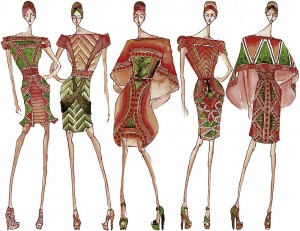
Green is the new black, as fashion designers worldwide continue to promote environment-friendly materials and socially responsible methods of production.
Look Magazine, Inquirer Lifestyle, and the British Council join the sustainable fashion movement with this year’s Look of Style Awards. Already on its third year, the competition continues to champion homegrown talent and the next generation of Filipino designers.
The winning designer among 10 finalists from Cebu, Davao and Manila will be awarded an all-expense-paid trip to the UK and a chance to enroll in a short course of his/her choice in London’s prestigious Central Saint Martins College of Art and Design. (The school’s alumni include fashion innovators: the late Alexander McQueen, eco-fashion advocates Stella McCartney and Katharine Hamnett, John Galliano, Phoebe Philo and Zac Posen.)
The winner will also receive business mentoring from fashion industry professionals, and a spot in Inquirer Lifestyle’s annual Face-Off fashion show.
With Eco-Chic as theme, this year’s competition goes a step further by addressing a global issue beyond the realm of fashion, changing the world in style.
On this spread, finalists share some of their design ideas for their eco-chic creations. They will be featured in the fashion show on Nov. 6 at Rockwell Tent, Plaza Garden, Rockwell Center, Makati City.
“It focuses on the beauty and potential of local organic material, as exhibited through modern sculptural silhouettes that mimic the natural curves, folds and blooms of a flower. Each piece is simultaneously structured or tailored and soft in appearance—a reflection of the similarities between the female form and a flower in bloom. This collection moves to showcase our local fabrics in a contemporary light.”—Vania Romoff
“Through my collection ‘Olio,’ I want to show strong modern lines and fluid silhouettes, with functional cuts, subtle folds and details, in colors like burgundy and moss green. I’ll be using a variety of materials: recycled, and a new fabric that’s piña mixed with rayon in ringge weave, which I’m developing with a local group.”—Roland Alzaté
Basic, accessible materials
“I collaborated with the Philippine Textile Research Institute to develop a fabric weave made from 100-percent PET (polyethylene terephthalate) bottles. Most of the pieces I’ll be creating are made from PET fabric accented with cutout rubber from the interior of an old tire. Part of my vision in sustaining eco-friendly fashion is introducing basic, accessible materials so that others would learn to appreciate and eventually continuously support sustainable fashion.”—Renan Pacson
“My concept, traveling gypsy, came from the idea of using old clothes and up-cycling them. I’ll be unseaming, dying and cutting them to create something new.”—Roxanne Hoey
“My collection is about the vast expansion of the Philippines’ coral reefs. I’ll be using scrap materials, specifically shredded lace manipulated to look like corals. I want to show people the importance of preserving our coral reefs. It’s part of my advocacy to show others that we’re lucky to have such a beautiful landscape, and that we should start protecting marine life.”—Hanz Coquilla
“My collection is a tribute to muslin, which designers have been using since the 17th century. It will be embellished with cut-out jusi and silk cocoon for transparency, with spikes made of clay and square appliqués made of bound sawdust. I plan to show others that muslin need not just be a ‘test fabric,’ but it could also be used like other expensive fabrics.”—Mike Yapching
“As I grew up in a small rural community, where folklore was part of my childhood, nature’s deities are the inspiration for my collection ‘Nympha.’ I’ll be using leftover materials from barong patched together to create a new pattern, and cutouts of different laces to make the look more modern.”—Rey Villegas
“My collection is inspired by the bird of paradise, recognized as one of the most beautiful exotic flowers, which resembles a brightly colored bird in flight. My collection will reflect the flower’s unique vivid shape through crocheted fabric interspersed with puyas beads, which are used by the T’boli tribe to adorn themselves.”—Ivan Raborar
“My collection is inspired by the vintas in Zamboanga City that embody the preserved culture of Zamboanga. I’ll feature prints through the use of natural dyes on piña and jusi and create pleats through fabric manipulation. I wish to show proper material organization and designation to prevent wastage of fabrics and excessive use of water and heat.”—Jun Artajo
“My collection features see-through effects, cascades of recycled coconut beads, and a play on proportions and colors using surplus piña and katsa fabrics.”—Dionesio Tarepe